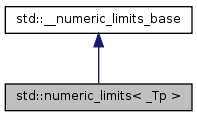Properties of fundamental types.
More...
List of all members.
Static Public Member Functions
Static Public Attributes
Detailed Description
template<typename _Tp>
struct std::numeric_limits< _Tp >
Properties of fundamental types.
This class allows a program to obtain information about the representation of a fundamental type on a given platform. For non-fundamental types, the functions will return 0 and the data members will all be false.
_GLIBCXX_RESOLVE_LIB_DEFECTS: DRs 201 and 184 (hi Gaby!) are noted, but not incorporated in this documented (yet).
Definition at line 284 of file limits.
Member Function Documentation
The minimum positive denormalized value. For types where has_denorm is false, this is the minimum positive normalized value.
Definition at line 313 of file limits.
The machine epsilon: the difference between 1 and the least value greater than 1 that is representable.
Definition at line 298 of file limits.
The representation of positive infinity, if has_infinity.
Definition at line 302 of file limits.
A finite value x such that there is no other finite value y where y < x.
Definition at line 294 of file limits.
The maximum finite value.
Definition at line 290 of file limits.
The minimum finite value, or for floating types with denormalization, the minimum positive normalized value.
Definition at line 288 of file limits.
The representation of a quiet Not a Number, if has_quiet_NaN.
Definition at line 306 of file limits.
The maximum rounding error measurement (see LIA-1).
Definition at line 300 of file limits.
The representation of a signaling Not a Number, if has_signaling_NaN.
Definition at line 309 of file limits.
Member Data Documentation
The number of radix digits that be represented without change: for integer types, the number of non-sign bits in the mantissa; for floating types, the number of radix digits in the mantissa.
Definition at line 199 of file limits.
The number of base 10 digits that can be represented without change.
Definition at line 201 of file limits.
True if loss of accuracy is detected as a denormalization loss, rather than as an inexact result. [18.2.1.2]/42
Definition at line 247 of file limits.
True if the type has a representation for positive infinity.
Definition at line 236 of file limits.
True if the type has a representation for a quiet (non-signaling) Not a Number.
Definition at line 239 of file limits.
True if the type has a representation for a signaling Not a Number.
Definition at line 242 of file limits.
True if the set of values representable by the type is finite. All built-in types are bounded, this member would be false for arbitrary precision types. [18.2.1.2]/54
Definition at line 255 of file limits.
True if the type uses an exact representation. All integer types are exact, but not all exact types are integer. For example, rational and fixed-exponent representations are exact but not integer. [18.2.1.2]/15
Definition at line 216 of file limits.
True if-and-only-if the type adheres to the IEC 559 standard, also known as IEEE 754. (Only makes sense for floating point types.)
Definition at line 251 of file limits.
True if the type is integer. Is this supposed to be if the type is integral?
Definition at line 211 of file limits.
True if the type is modulo, that is, if it is possible to add two positive numbers and have a result that wraps around to a third number that is less. Typically false for floating types, true for unsigned integers, and true for signed integers.
Definition at line 260 of file limits.
True if the type is signed.
Definition at line 208 of file limits.
This will be true for all fundamental types (which have specializations), and false for everything else.
Definition at line 194 of file limits.
The number of base 10 digits required to ensure that values which differ are always differentiated.
Definition at line 205 of file limits.
The maximum positive integer such that radix raised to the power of (one less than that integer) is a representable finite floating point number.
Definition at line 230 of file limits.
The maximum positive integer such that 10 raised to that power is in the range of representable finite floating point numbers.
Definition at line 233 of file limits.
The minimum negative integer such that radix raised to the power of (one less than that integer) is a normalized floating point number.
Definition at line 223 of file limits.
The minimum negative integer such that 10 raised to that power is in the range of normalized floating point numbers.
Definition at line 226 of file limits.
For integer types, specifies the base of the representation. For floating types, specifies the base of the exponent representation.
Definition at line 219 of file limits.
See std::float_round_style for more information. This is only meaningful for floating types; integer types will all be round_toward_zero.
Definition at line 269 of file limits.
True if tininess is detected before rounding. (see IEC 559)
Definition at line 265 of file limits.
True if trapping is implemented for this type.
Definition at line 263 of file limits.
The documentation for this struct was generated from the following file:

 1.7.1
1.7.1